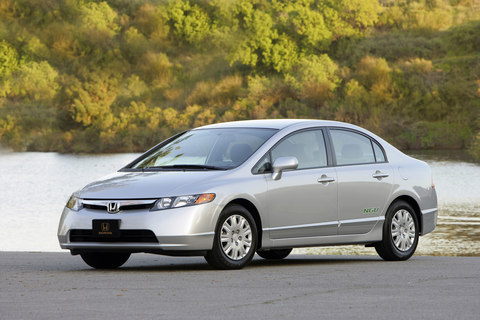It was introduced in July 1972 as a two-door coupe, followed by a three-door hatchback that September. With the transverse engine mounting of its 1169 cc engine and front-wheel drive like the British Mini, the car provided good interior space despite overall small dimensions. Early models of the Civic typically included a basic AM radio, heater, foam-cushioned plastic trim, two-speed wipers, and painted steel rims with a chromed wheel nut cap. As the years went by, it has become much more upscale with options such as air conditioning, power locks, power windows, leather upholstery, satellite-linked navigation, and a six-speed manual transmission. Initially gaining a reputation for being fuel-efficient, reliable, and environmentally friendly, later iterations have become known for performance and sportiness, especially the Civic Type-R, Civic GTi and Civic SiR.
The Civic has been rebadged for international markets with such models as the Honda Ballade and Honda Domani/Acura EL. The Civic platform also served as the basis for the CR-X sport compact, the CR-X del Sol targa convertible, and the CR-V compact SUV.
As of 2008, the Civic has been the top-selling car in Canada for eleven straight years.With high gas prices and a weak economy in June 2008, the Civic supplanted the Ford F-Series to become the top-selling vehicle in the United States for that month.
Civic sales in Japan are ending with the gas version ended in August 2010 and hybrid in December. International versions and hybrids will continue to be manufactured for sales outside of Japan.
Contents
* 1 First generation (1973–1979)
* 2 Second generation (1980-1983)
* 3 Third generation (1984–1987)
* 4 Fourth generation (1988–1991) - EC, ED, EE, EF
* 5 Fifth generation (1992–1995) - EG, EH, EJ1, EJ2
* 6 Sixth generation (1996–2000) - EK9, EK4, EK3, EJ6, EJ8, EJ9, EM1
* 7 Seventh generation (2001–2005) - EM2, ES1, EP3, EU1
* 8 Eighth generation (2006-2011) - FD2, FA1, FG1, FG2, FA5, FK, FN
o 8.1 2009 Facelift
* 9 International marketing and platform derivatives
* 10 Safety
o 10.1 USA
* 11 Modifications and the enthusiast community
* 12 Awards
* 13 Racing
o 13.1 Touring car racing
o 13.2 Drag and street racing
o 13.3 Grassroot racing
* 14 References and footnotes
* 15 External links
First generation (1973–1979)
1978-79 Honda Civic
Main article: Honda Civic (first generation
The first generation Honda Civic was introduced in 1972, but sold as a 1973 model. Equipped with a 1,169 cc (71.3 cu in) four-cylinder engine, the first generation Civic was designed to compete with American compact vehicles and offered features such as front power disc brakes and reclining vinyl bucket seats and AM radio. The Civic was available as a coupe, both a three- and a five-door hatchback, as well as a five-door station wagon. Due to the 1973 oil crisis, consumer demand for fuel efficient vehicles was high.
The CVCC engine debuted in 1975. Offered alongside the standard Civic engine, the 53 hp (40 kW; 54 PS) CVCC engine displaced 1,488 cc (90.8 cu in) and had a head design that allowed for more efficient combustion. The CVCC did not require a catalytic converter or unleaded fuel to meet emissions standards. Only the CVCC engine was available in California due to stricter emissions standards.
* EB1- 1169cc, black interior, honeycomb grill
* EB2- 1240cc, same body as the EB1, several choices for interior color
* EB3- 1240cc, revised hood, head rest on front seats, revised bumpers with plastic end caps, horizontal running grille, revised tail lights.
The first generation Honda Civics were notorious for rusting in less than three years from purchase where salt was used in the winter. The U.S. importer, American Honda Motor Company, signed a final consent decree with the Federal Trade Commission that provided owners of 1975-1978 Civics with rusted fenders the right to receive replacements or cash reimbursements.
Hondas were so vulnerable to corrosion that the National Highway Traffic Safety Administration (NHTSA) also issued a safety recall because lateral suspension arms, front crossbeam, and strut coil spring lower supports could weaken with exposure to salt. A total of 936,774 vehicles built between 9-1-1972 and 8-1-1979 were subject to extensive repairs since Honda had to replace the suspension components, or the automaker bought back entire cars with serious body corrosion. By 1981 about 10% of Hondas were to be inspected by a dealer and the automaker had 180 days to replace front fenders and supporting parts that showed rust within the first three years of use. At the time, Honda's rust recall was the largest safety action among all the brands imported into the U.S.
Second generation (1980-1983)
Civic 3-door
Main article: Honda Civic (second generation)
The second generation Honda Civic was introduced in 1980. It was larger, had a more angular shape, and came with increased engine power. All Civic engines now used the CVCC design, which added a 3rd valve per cylinder; this introduced lean burn swirl technology. The base 1335 cc ("1300") engine made 55 hp (41 kW), with an optional 1488 cc ("1500") engine giving 67 hp (50 kW). Three transmissions were offered: a four-speed manual (on base models), a five-speed manual, and a two-speed semi-automatic that was unique to the industry.
 Honda Civic
Honda Civic Honda Civic
Honda Civic Honda Civic
Honda Civic Honda Civic
Honda Civic Honda Civic
Honda Civic Honda Civic
Honda Civic Honda Civic
Honda Civic Honda Civic
Honda Civic Honda Civic
Honda Civic Honda Civic
Honda Civic



